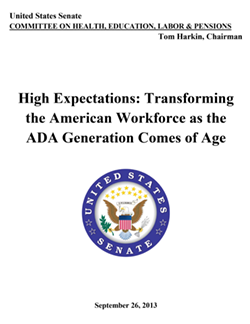The ADA Generation
For their entire lives, the law has prohibited discrimination against people with disabilities. Access ramps, handicapped parking spaces, closed captioning, and service animals have always been part of their landscape. They are the millennials, the first generation that has grown up experiencing the benefits of the Americans with Disabilities Act (ADA), enacted more than 25 years ago.
This “ADA Generation” is the most diverse in American history, projected to surpass baby boomers as the largest segment of the nation’s population. With their unique perspective and growing influence, the ADA Generation has the power to change the way Americans live and work over the next 25 years.
What challenges remain? And what additional steps are needed to allow people with disabilities to learn, work, and live in a world without barriers? Senator Tom Harkin, who championed the ADA in 1990, sat down with 11 millennials—students at Drake University who are part of the ADA Generation—to find out.

High Expectations: Transforming the American Workforce as the ADA Generation Comes of Age
In September 2013, as the chairman of the Senate Committee on Health, Education, Labor, and Pensions (HELP), former Senator Tom Harkin submitted a report focused on the young men and women who grew up in the era following the enactment of the Americans with Disabilities Act. High Expectations: Transforming the American Workforce as the ADA Generation Comes of Age focuses on how we can equalize opportunities for this unique group of young Americans as they seek competitive employment—opportunities in environments where individuals with and without disabilities work alongside one another.
Key findings from Senator Harkin’s ADA Generation report include:
- The ADA Generation has achieved unprecedented educational success in inclusive settings and has an expectation to be included as valued members of the American workforce.
- More and more Americans now see accessibility and accommodation as essential elements of an inclusive society, and not “special treatment” for a narrow population.
- Between 1997 and 2006, the number of students with disabilities leaving high school with a standard diploma increased from 43 to 57 percent. However, only 15 percent of high school graduates with disabilities attend a four-year college after leaving high school, as compared to 37 percent of young adults in the general population who complete their degree.
- Research indicates the best time to begin preparing for a career is during the middle school years. However, the Individualized Education Program (IPE) does not include employment and education transition planning goals until students are 16 years old.
- Supplemental Security Income (SSI) and Social Security Disability Insurance (SSDI) rely on an outdated definition of disability that assumes those with disabilities cannot work, and makes the eligibility for support services contingent upon young people proving with medical evidence that they cannot or will not be able to work and earn enough to support themselves.
- Federal policy requires young people with disabilities to declare they cannot work in order to receive income support and personal support services. Yet having these services would allow those with the most significant disabilities to be able to participate in and contribute to their communities, including being part of the workforce. Often, ineligibility for personal support services creates a paradoxical situation that limits choice for those who want to work but depend on support services.
- Under current law, an individual may not have assets greater than $2,000 to be eligible for SSI or Medicaid, which forces individuals with disabilities to choose between saving money or using financial and medical support services.
- In March 2013, more than 80 percent of recent veterans without a disability were employed or looking for work, compared to less than 45 percent of veterans with a disability.
- In June 2013, there was a 35.7-percent labor participation rate gap between Hispanic and Latino individuals aged 25 to 34 with disabilities and their non-disabled peers, a 13.4-percent gap between Asian individuals with and without a disability, and a 44.5-percent gap between African-American individuals with and without a disability.
- Research shows that employers overestimate the costs of providing workplace accommodations, underestimate the productivity of workers with a disability, and hold low expectations for the workplace performance of members of the ADA Generation. In reality, approximately 80 percent of workplace accommodations cost less than $1,000.

What do you think?
There are millions of members of the ADA Generation. Help us tap into their wealth of experiences and ideas by launching a worldwide conversation at #ADA30. Together we can do more to ensure people with disabilities in 2040 have equal access and opportunities in their workplaces and in their communities. But we need your voice.
Join the conversation today
Address: 2800 University Avenue, Des Moines, IA 50311
Phone: (515) 271-3623
Email: harkininstitute@drake.edu
Office Hours: Monday to Friday 9:00 a.m. to 4:00 p.m.



